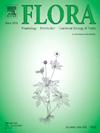Unveiling a longstanding misinterpretation: Revisiting the pattern formation of testa surface in Astragalus (Fabaceae, Astragaleae)
IF 1.7
4区 生物学
Q3 ECOLOGY
引用次数: 0
Abstract
As the largest plant genus among flowering plants, Astragalus requires a thorough evaluation of morphological and anatomical evidence to understand its evolutionary history, species relationships, and systematic placements. This study assesses seed surface patterns across various species and evaluates the variation and formation processes of testa ornamentation for taxonomic and phylogenetic purposes. Previous investigations have identified fixed features in several species that aid in species delimitation or characterize related groups. We examined seed surface characteristics, such as roughness under a stereomicroscope, cell shape, and cellular arrangement using Scanning Electron Microscopy, in 181 specimens representing 124 species and 55 sections of Astragalus, along with five species from related genera for comparison. We propose standardized terminology for seed surface characters to establish a consensus framework for future studies. Our results reveal distinct testa surface patterns within a single species and even within individual seeds as they develop. Initially, testa cells exhibit a polygonal isodiametric or elongated shape, which progressively narrows and spaces out, leading to the expansion and deepening of areas at the anticlinal walls. This pattern develops into an irregularly rugulate and ultimately a multi-reticulate form. Notably, A. annularis, A. epiglottis, and A. pelecinus display a rare cellular pattern akin to Phylolobium and Podlechiella vogelii, supporting their phylogenetic placement as the most basal clade in Astragalus. The verrucose-walled multi-reticulate pattern is characteristic of the Phaca clade, while an accelerated emergence of a multi-reticulate pattern in the Astracantha and Hypoglottis clades may indicate an advanced state. Future studies on seed surface patterns should consider these testa surface changes to address taxonomic issues within Astragalus and other Fabaceae genera.
求助全文
约1分钟内获得全文
求助全文
来源期刊

Flora
生物-植物科学
CiteScore
3.30
自引率
10.50%
发文量
130
审稿时长
54 days
期刊介绍:
FLORA publishes original contributions and review articles on plant structure (morphology and anatomy), plant distribution (incl. phylogeography) and plant functional ecology (ecophysiology, population ecology and population genetics, organismic interactions, community ecology, ecosystem ecology). Manuscripts (both original and review articles) on a single topic can be compiled in Special Issues, for which suggestions are welcome.
FLORA, the scientific botanical journal with the longest uninterrupted publication sequence (since 1818), considers manuscripts in the above areas which appeal a broad scientific and international readership. Manuscripts focused on floristics and vegetation science will only be considered if they exceed the pure descriptive approach and have relevance for interpreting plant morphology, distribution or ecology. Manuscripts whose content is restricted to purely systematic and nomenclature matters, to geobotanical aspects of only local interest, to pure applications in agri-, horti- or silviculture and pharmacology, and experimental studies dealing exclusively with investigations at the cellular and subcellular level will not be accepted. Manuscripts dealing with comparative and evolutionary aspects of morphology, anatomy and development are welcome.
 求助内容:
求助内容: 应助结果提醒方式:
应助结果提醒方式:


